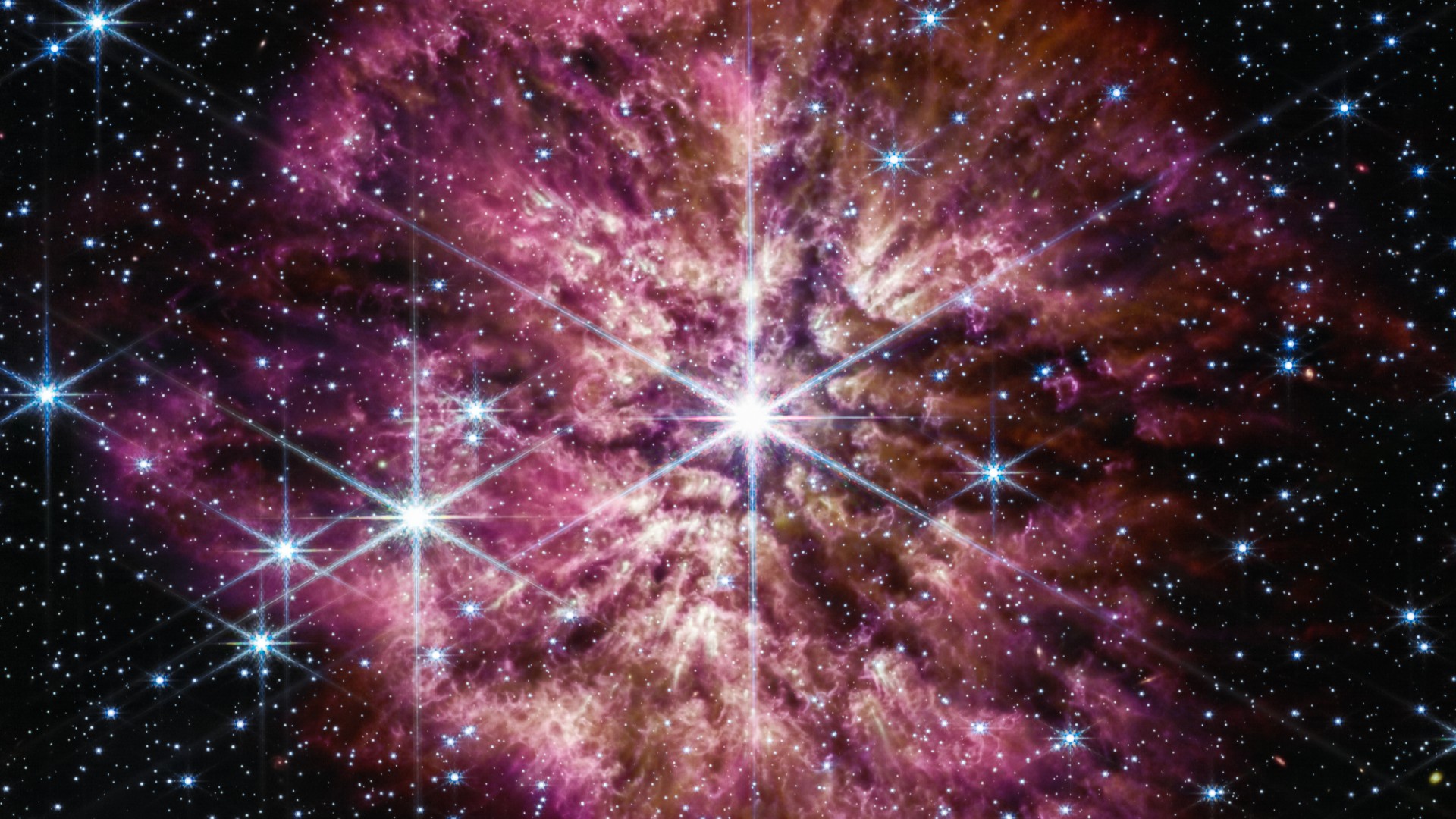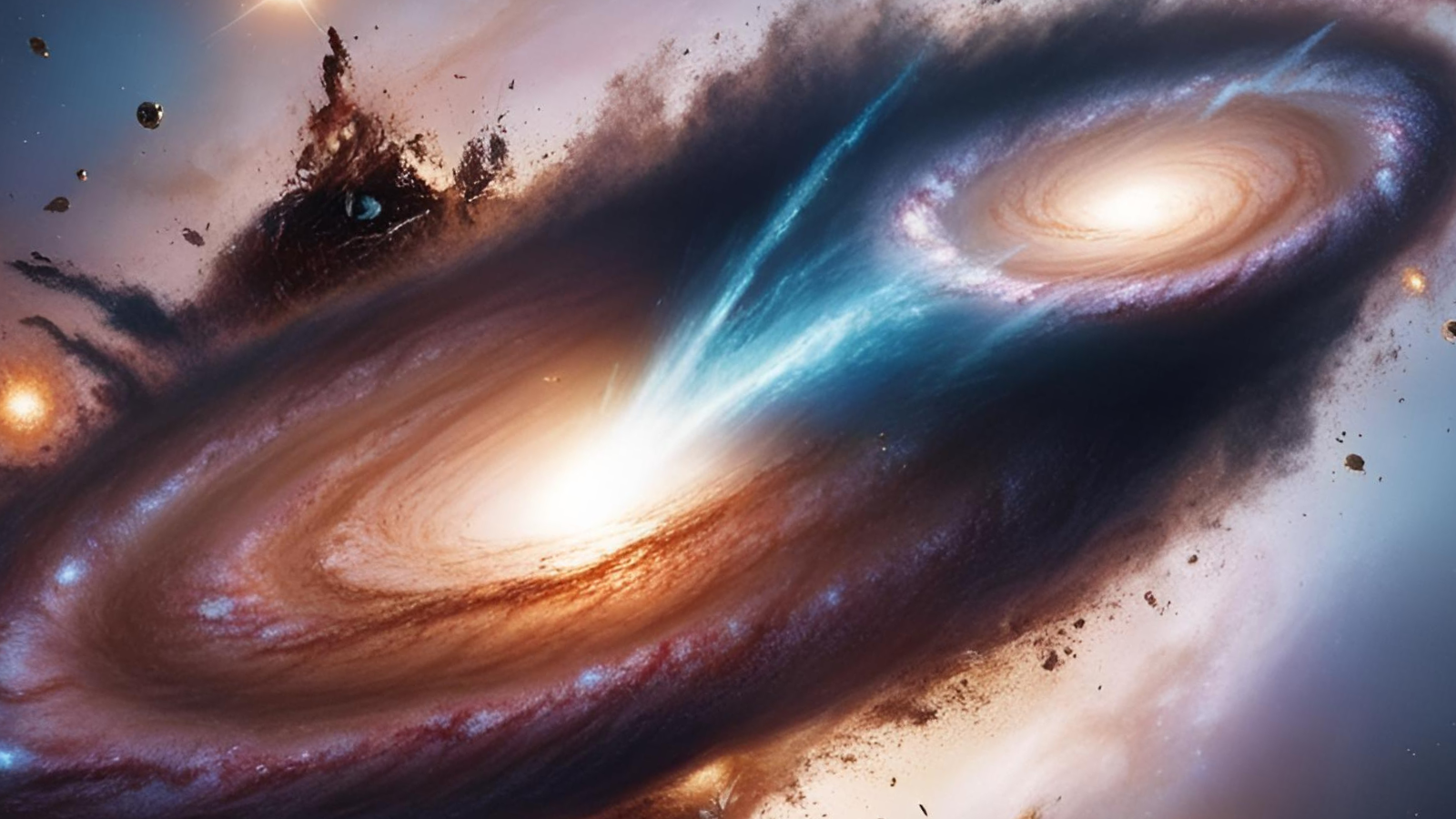A chaotic star is inching toward a violent death as astronomers watch in real-time
This might be the first observation of this rare type of star evolving in real time.

Every star ages, but astronomers rarely get to watch it happen in real time. Now, they've gotten a front-row seat to the aging of an unusually chaotic star — and found that it's headed toward a spectacularly violent death.
The star, located in the nearby Triangulum galaxy (also known as Messier 33), is in the middle of a transition into a class of highly unstable stars called Wolf-Rayet stars. New observations show that the star has begun beaming a new signal that was not seen when the star was first spotted in 2018.
The new signal was detected in the peaks and valleys of the star's spectra, the wavelengths of the electromagnetic radiation it emits, and shows that the star is churning either carbon or iron deep within it through nuclear fusion. The new signal also indicates that the massive star, easily 25 times the sun's mass, has inched closer to its eventual fate of exploding into a spectacular supernova.
Related: James Webb Space Telescope spots huge star about to go supernova (video, photos)
"It's really interesting that we have been able to see an actual change in the spectrum of the object in just four years," Olivia Gaunt, a graduate student at Tufts University in Massachusetts who is part of the new research, said Tuesday (June 6) while sharing the findings at the 242nd meeting of the American Astronomical Society, which is being held in Albuquerque, New Mexico, and online. "We believe this might be the first observation of a Wolf-Rayet star evolving in real time."
Gaunt's team is calling the star BELLS 1, an acronym for "broad emission-lined luminous sources, the kind of wide range of emissions radiated by Wolf-Rayet stars.
BELLS 1 probably began as a hot and massive star and rapidly lost its hydrogen reservoir by combining lighter elements into heavier ones through nuclear fusion. The rich spectra detected by Gaunt's team comes because of BELLS 1's furious winds, which blast out at 2.2 million to 5.4 million mph (3.5 million to 8.7 million km/h) and shed about 10 solar masses' worth of star matter every million years or so. The discarded stellar material is pumped back into the nearby universe, where it triggers the formation of future generations of stars and enriches them with recycled elements.
Get the Space.com Newsletter
Breaking space news, the latest updates on rocket launches, skywatching events and more!
When the team first observed BELLS 1 in 2018 using the Keck Observatory perched atop Mauna Kea volcano in Hawaii, the star featured three emission lines. But during their follow-up observations in 2022, BELLS 1 sported a new emission line, hinting that it took a step further in its short and energetic evolution. Shining with the light of millions of suns, BELLS 1 is now closer to the end of its 10 million-year lifetime. Once the star completely runs out of fuel, it will explode into what astronomers call a Type I supernova.
The new observations are exciting but not entirely surprising. "We do know that they exist on short timescales, so we expect to see rapid changes," Gaunt said at the news conference on Tuesday.
According to NASA, Wolf-Rayet stars like BELLS 1 live fast and die hard, so watching one evolve is a rare and valuable opportunity for astronomers. Only 200 such stars are known to be in the Milky Way galaxy. Astronomers suspect that 1,000 or 2,000 more may be out there but are obscured by thick blankets of dust.
Meanwhile, BELLS 1 is offering a bright performance, literally.
Join our Space Forums to keep talking space on the latest missions, night sky and more! And if you have a news tip, correction or comment, let us know at: community@space.com.

Sharmila Kuthunur is a Seattle-based science journalist focusing on astronomy and space exploration. Her work has also appeared in Scientific American, Astronomy and Live Science, among other publications. She has earned a master's degree in journalism from Northeastern University in Boston. Follow her on BlueSky @skuthunur.bsky.social
-
backcountrybum "Watch in real-time"?! The nearest galaxy is 25,000 light years away. Nothing we see is in real-time. Telescopes don't make light travel faster. Telescopes are light gathering devices.Reply -
ehb Reply
You can always use Google and get your information, but I will let you know it is in the Triangulum Galaxy (M33)OliverFord said:How about some coordinates so we can go look at this thing? -
Daconia Reply
The Stars catalogue number is GSC 01586-00411 also referred as Merril's Star. Aside from referring to events that happened 2.7 million years ago as "Real Time" this article did not even name the star. You can find it here:OliverFord said:How about some coordinates so we can go look at this thing?
RA 19h 11m 30.875s
DEC +16° 51′ 38.20″
Constilation Sagitta -
StenAntos I think the writer meant a Type II supernova instead of Type I. Type I are created by binary white dwarfs. WR stars are massive stars that should die in a Type II explosion.Reply -
The Density of Respect Reply
The article is correct as is. Type I and II supernovae are distinguished by the absence or presence of hydrogen in their spectra; since WR stars have shed their outer hydrogen layers it is not present in the spectrum when they explode, so they are type I.StenAntos said:I think the writer meant a Type II supernova instead of Type I. Type I are created by binary white dwarfs. WR stars are massive stars that should die in a Type II explosion.
The classification system is actually more complicated though, both types have further subclasses. The white dwarf explosions are type Ia specifically, while WR supernovae are Ib or Ic. -
tangentmink Location and Info for M33, the Triangulum Galaxy from In-the-Sky.org. You will need a somewhat powerful telescope to see this galaxy. You won't see this star without using imaging equipment.Reply
You may put your latitude and longitude in the right hand box on the screen for info specific to your location.
Tabs at the top are for other categories of objects. The OBJECTS / SKY DIAGRAM menu item gives a nice overview of what you can see in your sky for a given date/time.
I sometimes use this site for Star Party observation planning.
Cheers -
mikeash Reply
What they mean is they are witnessing the changes in spectra since 2018. Yes it was a long time ago however we can watch in our space in "real time", as it was.backcountrybum said:"Watch in real-time"?! The nearest galaxy is 25,000 light years away. Nothing we see is in real-time. Telescopes don't make light travel faster. Telescopes are light gathering devices. -
mikeash Reply
I so much liked the description of the this. Astounding !Admin said:Astronomers using the Keck Observatory have spotted a rare type of star evolving into a supernova right before their eyes.
A chaotic star is inching toward a violent death as astronomers watch in real-time : Read more -
Adoni Yannop BELL1 A Wolf-Rayet Star Of About 25 Solar Masses Will Go Supernova Soon!!Reply
BUTTE BELL1’s Supernova Will Not Be Because Of A “Core-Collapse” As Given Because The Neutronium Ball Of The Forming Neutron Center At The Core Of BELL1 Has Been Forming Since BELL1 Became A Star Millions Of Years Ago Through BELL1’s Pulsations): Compression-Decompression Cycles That Squeeze Heat From The Core Through The Siemens Refrigeration Cycle Compression To Heat, Heat Exchanger To Remove Heat, Decompression To Cool To Lower Temperature And Entropy And Increase Density Just As Hydrogen Is Converted To Liquid Hydrogen Through “Work Inputs”): Compression, Heat Exchanger, Decompression Cooling!!
The Point I Am Trying To Make Is The Core Of BELL1 Cannot Collapse Further Nor “Magically” As Given Because It Is Already At More Than 200 Trillion Times Earth Density!!
And That The Only Sure Way To Blow Up Bell1 Is To Convert 125 To 1250 Earth Masses Of Matter To Antimatter To Mix With An Equal Amount Of Matter To Create A 1.5e44 Joule To 1.5e45 Joule Supernova Explosion!!
More On The Mechanics Converting Matter To Antimatter On My YouTube Channel AdoniPhysics411 Or On My Next Post!!









